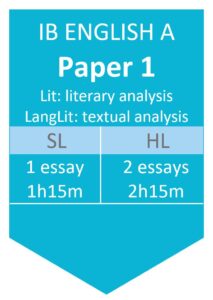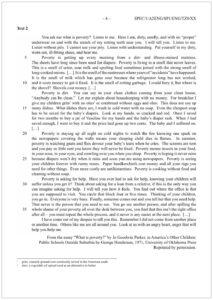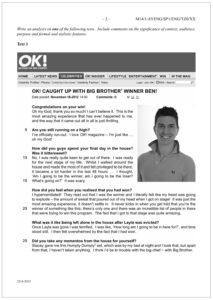Setting your Sights on Success
By The Edge Learning Center
IB English Paper 1: Analysing Structural Features

IB English A Paper 1
Paper 1 consists of two unseen passages, from two different text types, each accompanied by a guiding question.
Literature students analyse literature (e.g., a poem, an extract from a novel, short story or drama) whereas Language and Literature students analyse non-literature (e.g., a newspaper article, an advert, a comic strip, an essay, a memoir).
Standard Level (SL) students choose 1 passage and are given an hour and 15 minutes to write 1 essay whereas Higher Level (HL) students are given 2 hours and 15 minutes to write 2 essays.

Setting Your Sights on Success
Many students approach Paper 1 with one main goal, to find and analyse language devices. These include sentence structure, word choice, sensory imagery, and figurative language. Rarely do these students venture outside the scope of language devices into the realm of structural features—a shame, really, because they make up at least 50% of any given text type. So, if you’re not analysing for structure, you’re not attracting the examiner’s full attention.
Consider this, think of structural features like a text’s architecture—its style and layout, and language devices like a text’s interior-design features—it’s furniture, color scheme, and knick-knacks.
Now, imagine you’re a realtor describing a house to a potential buyer, but you only have images of the interior. You have no idea what the outside of the house looks like nor do you know what the floorplan looks like. But the buyer will want to know these. The buyer will want to know about the house’s style and layout:

- Is it Colonial? French Country? Or Greek Revival?
- How many rooms? What kind? Size? Shape?
- How are the rooms arranged? What’s the floorplan?
- Is there a front porch? A backyard? A garage?
Will such limited information, the probability of attracting the buyer’s interest is low. And since the realtor doesn’t know the answers to the buyer’s questions, the likelihood that the buyer will want to look at the house is even lower, and, unfortunately, brings into question the realtor’s credibility.
Ultimately, when analysing Paper 1, make it a point to know the structural features as these are integral to a text’s message. Bottomline, set your sights on both features and devices come exam day.
Structural Features
Analysing structure begins with the text type. The first thing you’ll want to do is look at how the writer is using the page. This means recognising the text type (e.g., poem, advert, essay, comic strip) and how its structural features help to convey the message.
Structural features include the big stuff, the visual aspects of a text that stand out without your having to read and process the text. These include titles, headers, menus, sidebars, mastheads, images, paragraphs, stanzas, line length, rhyme, rhythm, punctuation, dialogue, POV, event structure, argument structure, to mention most.
Analysing Structural Features
Let’s conclude with a look at some examples. The following 4 text types are based on IBDP past papers. The first two examples are from Literature past papers, and the next two examples are from Language and Literature past papers.
Analysing Form
Text Type poem, “Tantrum”, by AE Stallings
Features form, rhyme, rhythm
Poets use form to convey their message. For example, the Terza Rima structure of the poem “Tantrum” has a distinct interlocking rhyme scheme (aba, bcb, cdc, ded), conveying a sense of travelling forward while looking back, and illustrating the persona’s coming of age, one of the main thematic ideas Stallings explores in the poem.
Analysing Dialogue
Text Type novel extract, “How to live safely in a science fiction universe” by Charles Yu
Features narration, plot, character, conflict
Authors use dialogue to convey their message. In this extract, a quick glance of the page reveals an interchange between father and son becoming shorter and shorter:
“Kids at school say that you,” I start to say.
“That I? I’m what?”
“That you’re, uh.”
“Strange?”
“Crazy.”
The gradual decrease in line length, a form of decrescendo, connoting a loss for words, reveals the breakdown in communication between the father and son, one of the main thematic ideas the Yu explores in the extract.
Analysing Headings
Text Type magazine interview, “OK! Caught up with the Big Brother winner Ben!” by OK! Magazine
Features layout, image, color, font
Writers use headings to convey their message. Taking a look at the structure of the interview in OK! Magazine, the bold subheadings represent the interviewer’s questions and the non-bold text are the interviewee’s responses. Analysing subheadings on their own will give you a sense of the journalist’s argument structure. In this particular interview, the journalist controls the tone and direction of the interview through question types. For example, for sensational effect the journalist asks the winner of the “Big Brother” reality show if he had stolen “any mementos from the house” for himself”, the purpose of the question is to inject scandal and intrigue into the interview to keep the reader’s attention.

Analysing Argument Structure
Text Type essay extract, “What is Poverty?” by Jo Goodwin Parker
Features title, thesis, argument structure (talking points, transitions)
Writers use argument structure to convey their message. For example, Joe Goodwin Parker in her essay “What is Poverty?” presents a day-in-the-life account of what it means to live in poverty to illuminate readers about the truth of poverty. Through a chronological structure, Parker explains that “poverty is getting up every morning from a dirt- and ill-stained mattress”, and continues on throughout the day into “staying up all night…to watch the fire knowing one spark…means your sleeping child dies in flames.” Over the course of the essay, readers are led through the shame, disgust and humiliation of poverty, altering their understanding of poverty as more cruel and uglier than the world makes it out to be.
Robyn has extensive experience in HK teaching IB, AP, and (i)GCSE English. Join her classes to score high!
About The Edge
The Edge Learning Center is Hong Kong’s premier Test Preparation, Academic Tutoring, and Admissions Consulting services provider. Founded in 2008, The Edge has helped thousands of students improve their ACT and SAT scores as well as their IB and AP grades. The AC team has just finished off another successful period in which students gained acceptance to schools such as Columbia, Yale, UChicago, and more! Check out our latest Admissions Results!




